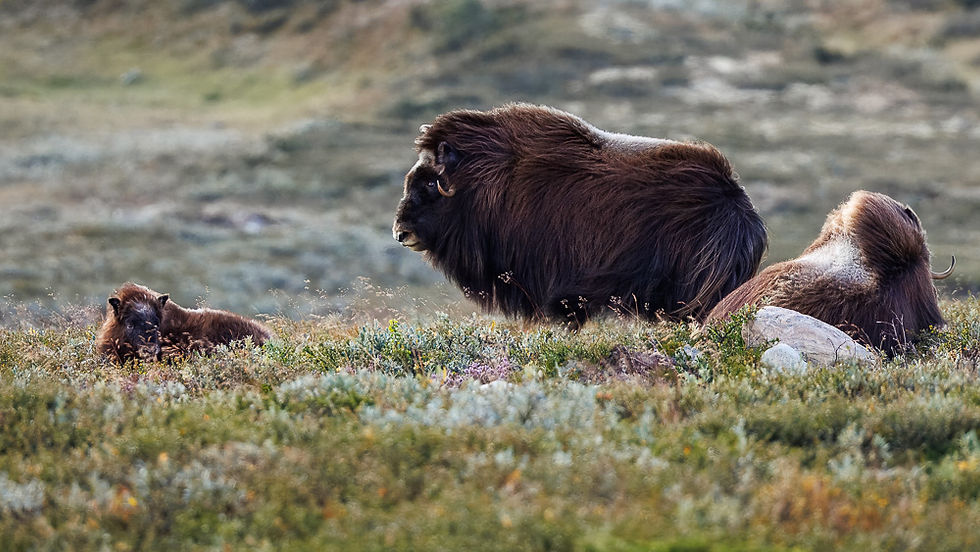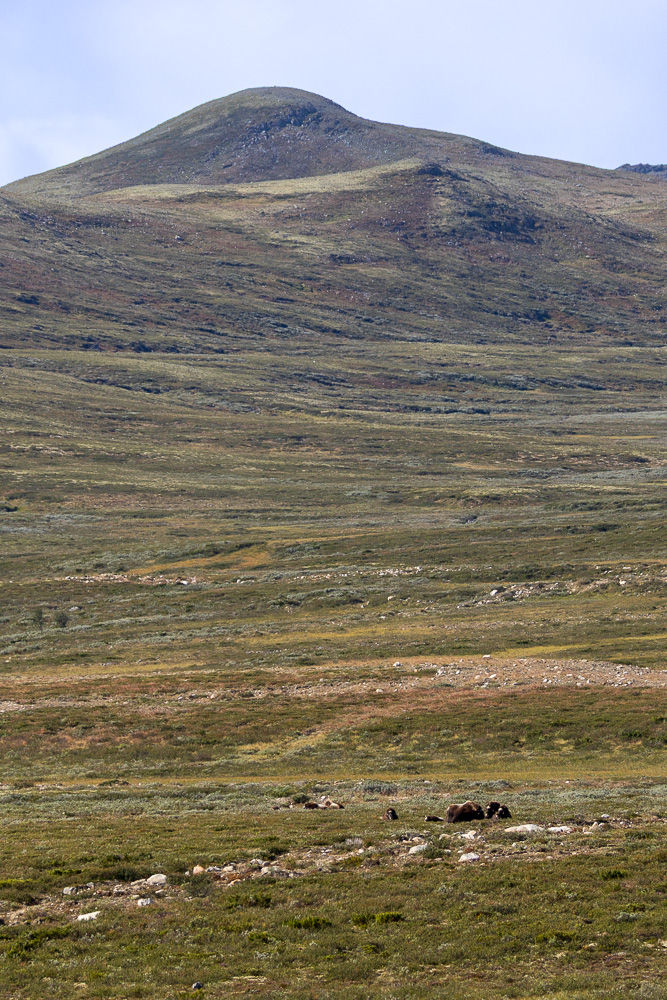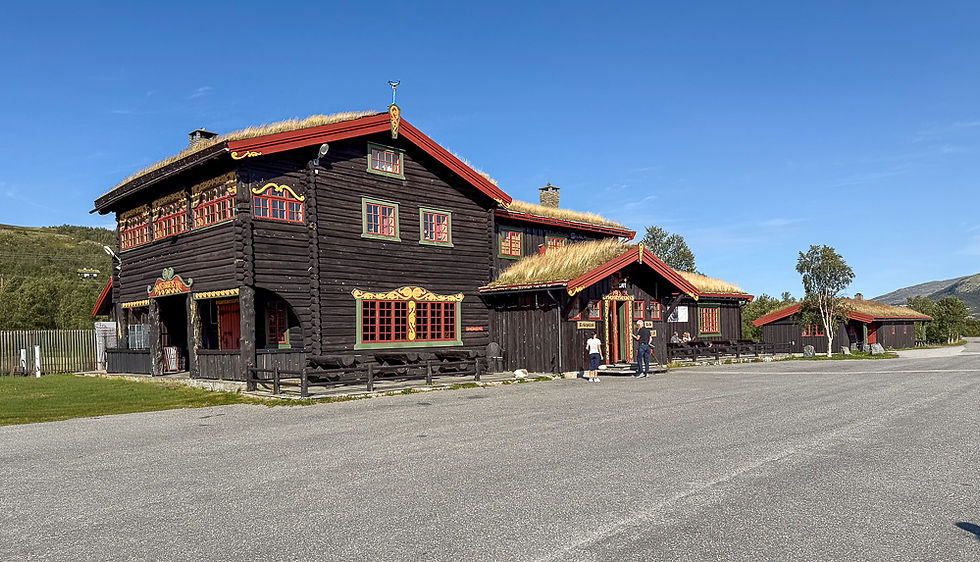Muskox at Dovrefjell - Norway's first rewilding of an extinct species - muskox safari in beautiful mountain scenery
- Admin

- Sep 5, 2025
- 10 min read
Updated: Sep 29, 2025
Until the last ice age thirty thousand years ago, muskoxen were a natural part of the fauna of Norway. But the strain that lives on Dovrefjell today was brought from Greenland in the first lastingly successful rewilding project in Norway. Daily muskox safaris are arranged where you can see muskoxen at close range. The muskox share terrain with the vulnerable population of wild reindeer - and with people who should act carefully and consider the animals.

Genetically, the muskox is more closely related to sheep and goats than to cattle. It originally comes from Alaska, the Arctic part of Canada and Greenland. It was only there that the muskox survived the last ice age. Before this, however, it was widespread in large areas of the northern hemisphere. In 1913, two well-preserved vertebrae from a muskox were found just north of Oppdal. This showed that these animals had also lived with us. This made researchers and enthusiasts want to reintroduce muskox.

On October 7, 1932, ten muskoxen were brought from Greenland - three males and four females - and released into the Dovrefjell Mountains just west of Hjerkinn Station. In the following years, at least four calves were born, showing that the muskox could survive here. But the population was small and vulnerable, and by the end of the war, there were no musk oxen left, due to hunting, accidents, and diseases.

After the second world war, a new attempt was made to reintroduce muskoxen to Dovrefjell. A total of twenty-seven calves were brought from Greenland between 1947 and 1953. Despite this, there were only ten individuals in August 1953. Consequently, there had been a high mortality rate due to disease and accidents. But it is these ten muskoxen that are the origin of today's strain of muskoxen on Dovrefjell.

In recent years, the goal has been to keep the winter population of muskoxen at approximately two hundred animals. Without regulation, the population would be larger, but for animal welfare reasons it is desirable to keep it at the current level. 60-70 calves are born each spring and about the same number of animals die during the year. The muskox has an average lifespan of 12 years for males and 20 years for females.

In 1971, five muskoxen migrated to Sweden and settled at Rogen in the border areas between Norway and Sweden. They formed a herd that numbered at most thirty animals in the 1980s, but due to problems with inbreeding it is much smaller today. They usually spend the winter in Sweden and the summer in Norway.

The muskox in Norway lives in the Dovrefjell-Sundalsfjella National Park, where an area of 340 square kilometers has been set aside in the municipalities of Oppdal, Dovre and Lesja. Here the muskoxen are allowed to roam freely. Animals that establish themselves outside this area are either chased back or killed if relocation is not successful. Animals that come too close to settlements are also killed.

The incidence of deaths due to disease and accidents is much higher in the Norwegian population than in the wild populations in Alaska, Canada, and Greenland. This is because the Norwegian animals have a much smaller area to move around, and that they often meet livestock, wild reindeer, deer, roe deer, and moose that can transmit infectious diseases. In recent years, there have been several outbreaks of contagious ecthyma and pneumonia that have claimed many lives. Most of the accidents are due to the muskoxen occasionally entering railway tunnels to seek shelter from harsh weather and being hit by trains.

After an absence of more than thirty thousand years, muskoxen are considered an alien species in this country. Therefore, a rewilding project for this species would not have been carried out today. But once it is here, the authorities take diligent care of it. It is protected, the animals are ensured to have a large enough area to avoid overgrazing, and tourism and safari activities are supervised. Frequent contact with humans can stress the animals and reduce their chances of surviving the winter. It is therefore recommended that you participate in a guided muskoxen safari rather than seeking out the animals on your own.

Muskoxen live in herds. In Alaska, Canada and Greenland, the herds are quite large, often 50-60 animals, but in Dovrefjell they are much smaller, usually only 8-10 animals. The musk oxen is a peaceful animal that poses no threat to us humans unless we get too close or provoke them. They spend most of their time grazing or relaxing to digest their food. This is also necessary to survive the winter. An adult muskox can weigh around 450 kilograms in the autumn. But the harsh climate makes it difficult to find enough food in the winter. In the spring, its weight can therefore be as low as 250 kilograms. If it is unable to regain its weight during the short summer, it can die of hunger during the following winter.



The Norwegian muskox rewilding project has been successful. Muskoxen have since been released in several locations in Alaska, Canada, Greenland, and Russia. In Russia, there are now twelve populations, the largest in Anabarski with 1,040 animals and the second largest in Bulunski with seven hundred individuals, in addition to Russia also having muskox on Wrangel Island in the Arctic Ocean. An overview shows that in 2020 muskox lived in fifty-five separate places in the world, and the international muskox population is considered viable. The Norwegian population is only a small part and is not considered for the Red List because it is an alien species and thus actually belongs on the blacklist.
But even though the Dovrefjell tribe has proven viable for almost 80 years, the future is uncertain because of climate changes. The muskox's fur has ten times the thermal insulation capacity of sheep's fur. This provides exceptionally good protection against cold and snow but causes problems when the weather gets too hot. Winters with alternating heat that melts the snow and cold that freezes it into ice can make it even more difficult for it to find enough food during the winter. Today, the muskox on Dovrefjell is a popular tourist destination that benefits the local community. A prosperous safari business provides income for both guides and accommodations. But if the climate becomes too warm, it may become extinct once again.

Dovrefjell-Sunndalsfjella National Park was originally established to protect the vulnerable wild reindeer population. Wild reindeer depend on moving across large areas. Originally, wild reindeer were found all over Norway, but because we humans have used much of nature, the grazing areas have become fragmented. Today, the wild reindeer are distributed across twenty-four small areas.

Dovrefjell-Sunndalsfjella National Park is one of the largest and most key areas for wild reindeer. The reindeer that live here are the only surviving tribe that descends from the original wild reindeer. Therefore, there is special protection for them in this area, and strict rules have been made to protect them. Wild reindeer are shy, and therefore you will not usually see them because they smell and see you before you notice them. However, if you seek them out and come closer than one kilometer, you can get a large fine.

Dovrefjell with its expanses and gentle mountain slopes is ideal for both muskox and wild reindeer. It is also a sought-after nature for those who love the mountains. For now, there is enough space for all of us, but that requires that we take care. The muskox and wild reindeer depend on being left alone to eat their fill for the winter. We don't.

If you want to see muskox, it is worth signing up for a guided muskox safari. A herd of musken can move up to thirty kilometers in a day or night. The muskox range is large, and it can therefore be exceedingly difficult to find them if you do not know where they are. It is also safer to go with a guide who knows where to go and where to go carefully. When a muskox is lying down, it may only stick out 30 cm from the ground. This means that you risk getting too close before you notice it, and dangerous situations can arise.

About muskox safari:
The musk ox safaris at Dovrefjell are run in a sustainable manner. The business is well regulated, and the animals are not stressed to any great extent. You can therefore participate in them with a clear conscience.
Muskox safaris usually start at 9 am. It is therefore an advantage to stay overnight nearby. The starting point for the safaris can vary from day to day since muskox herds can move far in just one day or one night. It is therefore advisable to have your own car so that you can easily get to the meeting point for the day.
The professional guides spend a lot of time keeping track of where the animals are. However, you should expect to walk 1-3 hours to see the animals. A typical safari will take 5-6 hours but can also take longer. Bring food and drink and enough clothing. The weather can change quickly in the mountains, and even if it looks nice when you leave, it can be windy, rainy, and cold during the trip. It is an advantage to have mountain boots, or good hiking shoes. Anyone in normal physical shape will be able to complete a muskox safari, but it can be tiring, especially if you have a heavy backpack.

You can book a guide via Dovregubbens hall. They usually use muskox guide Kinge Røstad who can also be contacted directly via Facebook. He has 20 years of experience and spends a lot of time both in the evening and in the morning scouting the terrain to keep up to date on where it is easiest to find musk for the day's safari. We had a particularly enjoyable experience with him, but there are also other musk guides and accommodations you can contact.
If you use a good guide, you are almost 100 percent sure to see muskox. Even though you get quite close to the animals, it is an advantage to bring binoculars or a camera with a telephoto lens. There are good opportunities to take pictures, but if you are particularly interested in photography, it may also be worthwhile to book a guided photo safari. These are usually arranged in the winter months and take place on snowshoes. You start before sunrise and finish after sunset so that you get the most beautiful light. It is an advantage to have a telephoto lens of 400 mm or more if you want to get close-up photos of the musk deer. A regular musk deer safari during the tourist season cost 650 Norwegian kroner in 2025. A photo safari cost 1200 kroner.
More rewilding: en.turideer.com/blank-3
More excursions: www.turideer.com
Excursion of the week: Muskox at Dovrefjell - muskox safari in beautiful mountain scenery at Dovrefjell.
Finding it: The mountain hotel "Dovregubbens hall" (info@dovregubben.com, tel: +47 612 42 917) is a good starting point because it is located right next to the muskox area. Here you can stay in a hotel room or rent a cabin. Enter "Dovregubbens hall" in Google Maps, and you will be taken directly to the place. Alternatively: drive the E6 from Dombås towards Trondheim. The hotel is located on the left side of the road about twenty-one kilometers from Dombås (about 19 minutes by car).




Comments